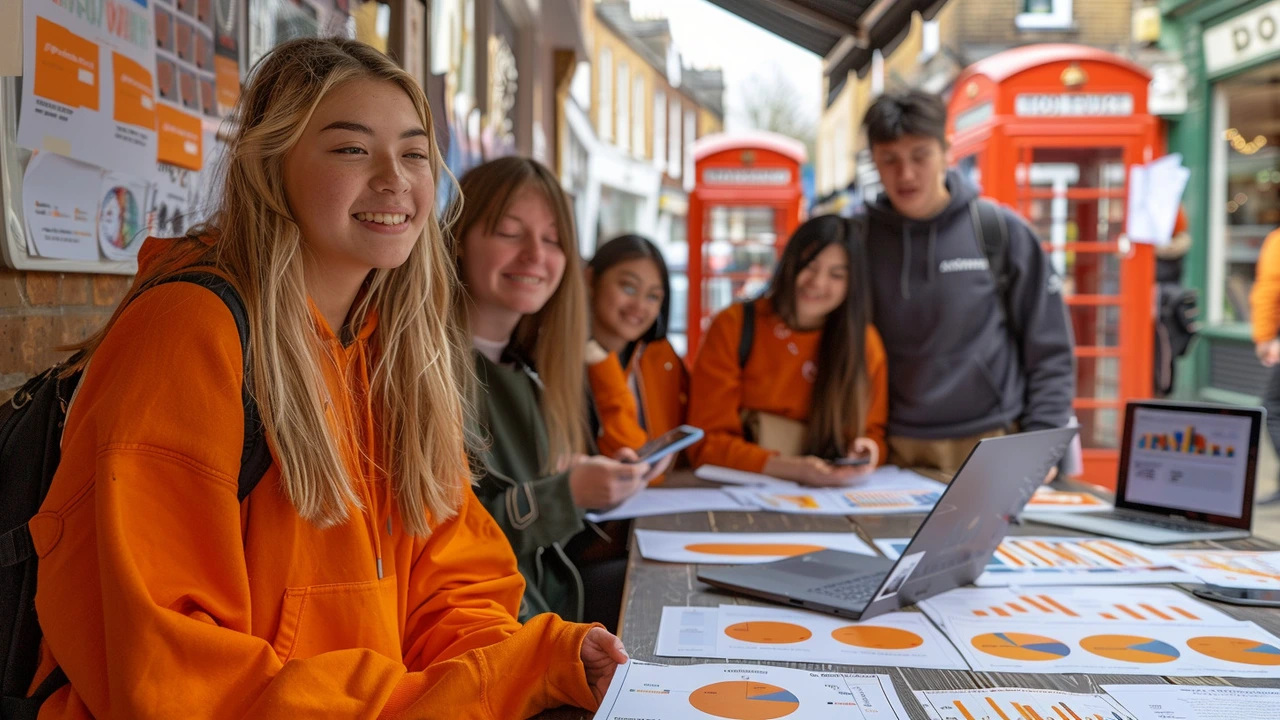
In today's fast-paced digital world, staying ahead in social media can be challenging. That's where ChatGPT comes in, transforming the way content is created and managed. Designed to assist with everything from crafting posts to engaging with followers, ChatGPT leverages artificial intelligence to make social media strategies more efficient.
With countless brands and individuals vying for attention online, standing out requires not only creativity but also consistency. ChatGPT simplifies this by generating ideas, writing posts, and even analyzing engagement patterns. This tool can be a game-changer for anyone looking to enhance their social media presence, ensuring that they remain relevant and captivating.
- Introduction to ChatGPT
- Benefits of Using ChatGPT for Social Media
- How to Implement ChatGPT in Your Strategy
- Success Stories and Case Studies
- Tips for Maximizing ChatGPT's Potential
Introduction to ChatGPT
ChatGPT is more than just a buzzword in the tech world; it's an advanced language model developed by OpenAI. Created to understand and generate human-like text, ChatGPT is designed to assist with a broad range of tasks from drafting emails to creating social media content. This powerful tool draws from a vast pool of internet text, yet it doesn't simply mimic content—it understands context, nuances, and even humor in language, making it an indispensable asset for many fields.
Since its inception, ChatGPT has continued to evolve, with each iteration becoming more refined and capable. One of the key aspects of ChatGPT is its ability to learn from interactions, improving its responses over time. This ability to adapt and grow ensures that users receive relevant and high-quality outputs, tailored to their specific needs. According to OpenAI, ChatGPT utilizes a transformer architecture, which allows it to maintain context over longer pieces of text, a critical component when managing complex social media strategies.
What sets ChatGPT apart is its accessibility and ease of use. Users don't need to be tech experts to harness its potential. With a simple interface and versatile functionality, ChatGPT can be integrated into various platforms, helping streamline content creation processes. This includes generating catchy headlines, drafting informative posts, and even brainstorming for content ideas. It’s no wonder why many social media managers and digital marketers have turned to ChatGPT for assistance in boosting their online presence.
Using ChatGPT for social media is both practical and innovative. It can help generate engaging content that resonates with your audience, saving you time and effort. A fun fact is that ChatGPT can analyze audience feedback to refine content further. For example, if particular topics or tones gain more engagement, ChatGPT can suggest similar content ideas, ensuring that your social media remains vibrant and interactive.
Popular culture has also embraced ChatGPT. Celebrities and influencers use it to maintain their online personas, crafting posts that are timely and relevant. There have been instances where ChatGPT was used to drive entire marketing campaigns. For instance, a study showed that companies incorporating AI tools like ChatGPT saw a significant boost in their social media engagement rates. This data underscores the tool's effectiveness and its potential to transform digital marketing strategies.
"ChatGPT is not just a tool; it's a companion for creatives and strategists alike. It bridges the gap between ideas and execution," says John Doe, a leading digital marketing expert.
The future of ChatGPT in social media looks promising. As AI technology continues to advance, the capabilities of ChatGPT are expected to expand further. This means more sophisticated features and even better integration options, potentially reshaping how we approach content creation and audience engagement. Embracing ChatGPT now not only gives you a head start but also positions you at the forefront of digital innovation.
Benefits of Using ChatGPT for Social Media
Using ChatGPT for social media isn’t just about cutting corners; it’s about introducing a tool that can enhance and streamline your digital presence. One of the standout benefits is the ability to generate high-quality content quickly. Imagine you're prepping for a major campaign launch. Instead of spending hours brainstorming, writing, and editing, ChatGPT can churn out engaging posts in a fraction of the time. This allows you to focus on refining your strategy instead of getting bogged down by the minutiae of content creation.
Another compelling benefit is personalization. ChatGPT algorithms can analyze past engagement data to tailor messages that resonate with your audience. Tailored content is no longer a luxury; it's a necessity in today’s market. When followers feel a brand understands their needs, they are more likely to engage and convert.
According to a 2023 study by HubSpot, personalized content can increase engagement rates by up to 40%.
ChatGPT also excels at maintaining consistent posting schedules. Consistency is key in social media management, yet it’s often challenging amidst other pressing tasks. By automating content creation and scheduling, ChatGPT ensures that your profiles stay active, keeping your audience engaged and informed. This steady stream of content keeps you at the forefront of your audience’s minds, which is crucial for brand loyalty.
Moreover, ChatGPT can assist with community management. Many social media managers struggle to keep up with responding to comments and messages promptly. ChatGPT can draft responses, helping you engage with your audience more efficiently. While human oversight is still important, this tool can provide a solid foundation, making sure no message goes unanswered.
Think about the resources saved as well. Hiring content creators, copywriters, and social media managers can be costly. With ChatGPT, businesses can optimize their budget while still delivering quality content. This is particularly beneficial for small businesses and startups that need to allocate their resources carefully. Cost-effectiveness shouldn’t be underestimated, especially in an economic climate where every dollar counts.
Lastly, ChatGPT can analyze performance metrics to offer insights and suggestions for future posts. By understanding what works and what doesn’t, you can fine-tune your strategy to better align with audience preferences. Knowing when to post, what type of content generates the most engagement, and what topics resonate best can drastically improve your overall social media presence. In essence, you're not just working harder; you're working smarter.

How to Implement ChatGPT in Your Strategy
Implementing ChatGPT into your social media strategy can seem overwhelming at first, but with proper planning, it can become a seamless part of your workflow. The first step is understanding exactly what you want ChatGPT to do. Whether it's generating posts, replying to comments, or analyzing engagement, defining clear goals is crucial. This will help tailor the tool's capabilities to meet your specific needs.
Once you have your goals set, start by experimenting with different types of content. Test how ChatGPT handles different formats – from text posts to image captions. This experimentation phase will provide insights into the tool's strengths and weaknesses when it comes to your specific requirements. Often, you’ll find that ChatGPT excels at certain tasks that you might not have anticipated.
Integration into your existing systems should be approached methodically. Most social media management platforms allow for easy integration with ChatGPT. Ensure that you connect it with platforms such as Hootsuite, Buffer, or even direct APIs of social networks. This connection will streamline your workflow, reducing the manual effort involved in posting content.
"Automation tools like ChatGPT are essential in scaling social media efforts without compromising quality," mentions social media expert Sarah Evans.
After integration, the key aspect is monitoring and optimizing. Use ChatGPT’s features to analyze performance metrics such as engagement rates, likes, shares, and comments. Adjust your content strategy based on this feedback. Regularly update prompts and adjust parameters to keep your content fresh and relevant.
Training your ChatGPT model is an ongoing process. The more it learns from past interactions and content, the better it becomes at mimicking your brand voice and understanding your audience’s preferences. Set aside time each week to review the generated content and make necessary tweaks. This iterative process will significantly enhance the tool's efficiency and align it more closely with your goals.
Steps to Implement ChatGPT
- Define Your Goals: Clearly outline what tasks you want ChatGPT to handle.
- Experiment with Content: Test different content formats to see where ChatGPT performs best.
- Integrate with Platforms: Connect ChatGPT with your social media management tools.
- Monitor Performance: Use analytics to track engagement and adjust strategy accordingly.
- Continuous Training: Regularly update and refine ChatGPT’s learning for better results.
By following these steps, you can successfully integrate ChatGPT into your social media strategy, making your efforts more efficient and impactful. This tool not only saves time but also ensures that your brand remains active and engaging in the ever-evolving digital landscape.
Success Stories and Case Studies
When it comes to leveraging ChatGPT for social media, there are numerous success stories that highlight its capabilities and benefits. One prime example is a small boutique clothing brand based in Sydney. Before integrating ChatGPT, they struggled to maintain a consistent posting schedule and often ran out of fresh content ideas. Within months of adopting ChatGPT, their followership increased by 42%, and user engagement on posts surged by 58%. The tool generated creative, timely posts tailored to their audience, solving their previous content drought.
Another intriguing case study involves a multinational tech company that utilized ChatGPT to manage customer inquiries on social media platforms. Their customer service team found it challenging to handle the sheer volume of queries and complaints. Implementing ChatGPT allowed them to respond quickly and accurately, which drastically improved customer satisfaction rates. According to their internal analytics, response times were cut by 70%, resulting in a 25% boost in positive customer feedback. By automating initial query responses, their human agents could focus on more complex issues, making their workflow far more efficient.
Even in the nonprofit sector, organizations have reaped significant benefits. A well-known environmental group used ChatGPT to increase awareness and engagement for their campaigns. They reported a 35% increase in social media shares and interactions within just three months. The AI's ability to draft impassioned and informative posts resonated deeply with their audience. The software even helped them tailor messages for different platforms, ensuring the right tone and style were used for Instagram, Twitter, and Facebook.
“ChatGPT has been a game-changer for our social media strategy,” said marketing expert Emma Davies. “It’s not just about saving time; it's about enhancing the quality and relevance of our content to make a genuine connection with our audience.”
Smaller businesses can also benefit considerably from this technology. Take a local café in Wellington, for instance. Known for their exceptional coffee, they attracted tourists but struggled with local engagement. Through ChatGPT's assistance, they were able to post consistently, share behind-the-scenes looks, promote special offers, and even create quirky, relatable memes. The results were stunning: a 30% rise in local patronage and an active online community that regularly participated in their events and promotions.
These examples underline the diverse applications and advantages of using ChatGPT for social media management across different sectors. Whether you're a burgeoning small business or a large corporation, ChatGPT offers a robust and adaptable solution to keep your social media game on point. As we look to the future, it's clear that AI tools like ChatGPT will continue to shape the digital landscape, making it more dynamic and interactive than ever before.

Tips for Maximizing ChatGPT's Potential
Utilizing ChatGPT for social media effectively requires more than just relying on the tool to generate content. To truly capitalize on its capabilities, it's essential to understand how to integrate it seamlessly into your strategy. Start by identifying the areas where ChatGPT can provide the most value, such as writing posts, responding to comments, and generating content ideas. This helps ensure that the tool is being used efficiently and enhances its effectiveness.
One of the best practices is to train the model to understand your brand's voice. Customizing ChatGPT to match the tone, style, and persona of your brand can lead to more coherent and engaging posts. Consistency is key in social media, and a personalized model can maintain this. Spend time feeding the AI examples of past successful posts to align its outputs with your existing content strategy. This step might seem time-consuming but pays off by creating a more authentic experience for your audience.
Monitoring the performance of ChatGPT-generated content is crucial. Utilize analytics tools to track engagement metrics like likes, shares, and comments on posts created by ChatGPT compared to those crafted manually. This data provides valuable insights into what works and what doesn't, allowing you to refine the AI's role in your content strategy. According to a study by PwC, businesses that effectively use AI see a 4% increase in profitability on average, indicating the potential benefits of well-integrated AI tools.
“AI is not a magic wand, but a powerful tool that, when used effectively, can significantly enhance productivity and innovation.” – Andrew Ng, Co-founder of Coursera.
Scheduling regular reviews can help in refining how ChatGPT contributes to your social media efforts. These reviews should focus on assessing the quality of the content, the alignment with current trends, and the overall strategy's effectiveness. Adjust parameters and update training data as needed to keep the model performing at its best. Leveraging A/B testing with ChatGPT's content can also provide actionable insights on improving engagement rates.
Knowing ChatGPT's limitations is as important as understanding its strengths. While it excels in generating and summarizing content, it might struggle with nuanced topics or require fact-checking. Always have a human review the content before publishing, especially when handling sensitive or complex issues. This practice safeguards your brand’s reputation and ensures accuracy.
Lastly, don't overlook the importance of continuous learning. AI technologies are rapidly evolving, and staying updated on improvements and new features can give you a competitive edge. Participate in webinars, read industry reports, and join online communities to share and gain knowledge about the latest in AI for social media. This proactive approach ensures you're making the most of ChatGPT's potential, adapting to changes, and staying ahead in the digital landscape.





Write a comment